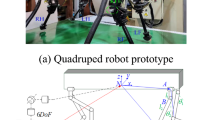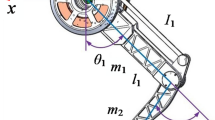Abstract
Robots driven by batteries are clean, quiet, and can work indoors or in space. However, the battery endurance is a great problem. A new gait parameter design energy saving strategy to extend the working hours of the quadruped robot is proposed. A dynamic model of the robot is established to estimate and analyze the energy expenditures during trotting. Given a trotting speed, optimal stride frequency and stride length can minimize the energy expenditure. However, the relationship between the speed and the optimal gait parameters is nonlinear, which is difficult for practical application. Therefore, a simplified gait parameter design method for energy saving is proposed. A critical trotting speed of the quadruped robot is found and can be used to decide the gait parameters. When the robot is travelling lower than this speed, it is better to keep a constant stride length and change the cycle period. When the robot is travelling higher than this speed, it is better to keep a constant cycle period and change the stride length. Simulations and experiments on the quadruped robot show that by using the proposed gait parameter design approach, the energy expenditure can be reduced by about 54% compared with the 100 mm stride length under 500 mm/s speed. In general, an energy expenditure model based on the gait parameter of the quadruped robot is built and the trotting gait parameters design approach for energy saving is proposed.
















Similar content being viewed by others
References
RAIBERT M, BLANKESPOOR K, NELSON G, et al. Bigdog, the rough-terrain quadruped robot[C]//Proceedings of the 17th World Congress, The International Federation of Automatic Control, Seoul, July 6–11, 2008: 10823–10825.
SEMINI C, TSAGARAKIS N G, GUGLIELMINO E, et al. Design of HyQ—a hydraulically and electrically actuated quadruped robot[J]. Proceedings of the Institution of Mechanical Engineers, Part I: Journal of Systems and Control Engineering, 2011, 225(6): 831–849.
JIN H D, SEOK S, LEE J, et al. High speed trot-running: Implementation of a hierarchical controller using proprioceptive impedance control on the MIT Cheetah[J]. The International Journal of Robotics Research. 2014, 33(11): 1417–1445.
BOAVENTURA T, BUCHLI J, SEMINI C, et al. Model-Based hydraulic impedance control for dynamic robots[J]. IEEE Transactions on Robotics, 2015, 31(6): 1324–1336.
IQBAL J, TAHIR A M. Robotics for nuclear power plants–challenges and future perspectives[C]//2012 2nd International Conference on Applied Robotics for the Power Industry, Islamabad, Pakistan, September 11–13, 2012: 151–156.
MURPHY R R, TADOKORO S, NARDI D, et al. Springer handbook of robotics[M]. Berlin: Springer, 2008.
JUNYAO G, Wei B, JIANGUO Z. Coal mine detect and rescue robot design and research[C]//IEEE International Conference on Networking, Sensing and Control, Sanya, April 6–8, 2008: 780–785.
PAN Yang, GAO Feng, QI Chenkun, et al. Human-tracking strategies for a six-legged rescue robot based on distance and view[J]. Chinese Journal of Mechanical Engineering. 2016, 29(2): 219–230.
XU Yilin, GAO Feng, PAN Yang, et al. Method for six-legged robot stepping on obstacles by indirect force estimation[J]. Chinese Journal of Mechanical Engineering. 2016, 29(4): 669–679.
FISCHER M, WERBER M, SCHWARTZ P V. Batteries: Higher energy density than gasoline[J]. Energy policy, 2009, 37(7): 2639–2641.
MADDEN J D. Mobile robots: motor challenges and materials solutions[J]. Science, 2007, 318(5853): 1094–1097.
ALEXANDER R M. Three uses for springs in legged locomotion[J]. The International Journal of Robotics Research, 1990, 9(2): 53–61.
LAFFRANCHI M, TSAGARAKIS N G, CANNELLA F, et al. Antagonistic and series elastic actuators: a comparative analysis on the energy consumption[C]//IEEE/RSJ International Conference on Intelligent Robots and Systems, Louis, October 11–15, 2009: 5678–5684.
GREGORIO P, AHMADI M, BUEHLER M. Design, control, and energetics of an electrically actuated legged robot[J]. IEEE Transactions on Systems, Man, and Cybernetics, Part B: Cybernetics, 1997, 27(4): 626– 634.
ACKERMAN J, SEIPEL J. Energy efficiency of legged robot locomotion with elastically suspended loads[J]. IEEE Transactions on Robotics, 2013, 29(2): 321–330.
CHEN Xianbao, GAO Feng, Qi Chenkun, et al. Spring Parameters Design for the New Hydraulic Actuated Quadruped Robot [J]. Journal of Mechanism and Robotic, 2014, 6(2): 021003.
ALEXANDER R M. Energy-saving mechanisms in walking and running[J]. Journal of Experimental Biology, 1991, 160(1): 55–69.
HOYT D F, WICKLER S J, COGGER E A. Time of contact and step length: the effect of limb length, running speed, load carrying and incline[J]. Journal of Experimental Biology, 2000, 203(2): 221–227.
HOYT D F, WICKLER S J, DUTTO D J, et al. What are the relations between mechanics, gait parameters, and energetics in terrestrial locomotion[J]. Journal of Experimental Zoology Part A: Comparative Experimental Biology, 2006, 305(11): 912–922.
MINETTI A, ARDIGO L, REINACH E, et al. The relationship between mechanical work and energy expenditure of locomotion in horses[J]. Journal of Experimental Biology, 1999, 202(17): 2329–2338.
CAVAGNA G A, FRANZETTI P, HEGLUND N C, et al. The determinants of the step frequency in running, trotting and hopping in man and other vertebrates[J]. The Journal of Physiology, 1988, 399(1): 81–92.
HOLT K G, HAMILL J, ANDRES R O. Predicting the minimal energy costs of human walking[J]. Medicine and Science in Sports and Exercise, 1991, 23(4): 491–498.
HOLT K G, JENG S F, RATCLIFFE R, et al. Energetic cost and stability during human walking at the preferred stride frequency[J]. Journal of Motor Behavior, 1995, 27(2): 164–178.
AHLBORN B K, BLAKE R W. Walking and running at resonance[J]. Zoology, 2002, 105(2): 165–174.
ZHANG Jiaqi, GAO Feng, HAN Xiaolei, et al. Trot gait design and CPG method for a quadruped robot[J]. Journal of Bionic Engineering, 2014, 11(1): 18–25.
CHEN Xianbao, GAO Feng, QI Chenkun, et al. Spring parameters design to increase the loading capability of a hydraulic quadruped robot[C]//IEEE International Conference on Advanced Mechatronic Systems, Luoyang, September 25–27, 2013: 535–540.
CHEN Xianbao, GAO Feng, QI Chenkun, et al. Gait planning for a quadruped robot with one faulty actuator[J]. Chinese Journal of Mechanical Engineering, 2015: 1–9.
GAO Feng, QI Chenkun, SUN Qiao, et al. A quadruped robot with parallel mechanism legs[C]//IEEE International Conference on Robotics and Automation (ICRA), Hong Kong, June 1–5, 2014: 2566–2566.
Author information
Authors and Affiliations
Corresponding author
Additional information
Supported by National Basic Research Program of China (973 Program, Grant No. 2013CB035501).
Rights and permissions
About this article
Cite this article
Chen, XB., Gao, F. Energy Expenditure of Trotting Gait Under Different Gait Parameters. Chin. J. Mech. Eng. 30, 943–950 (2017). https://doi.org/10.1007/s10033-017-0110-8
Received:
Revised:
Accepted:
Published:
Issue Date:
DOI: https://doi.org/10.1007/s10033-017-0110-8




